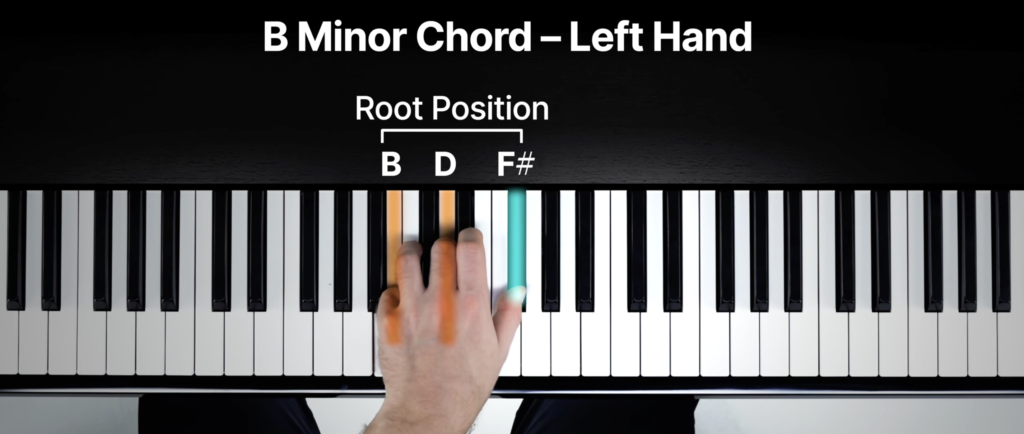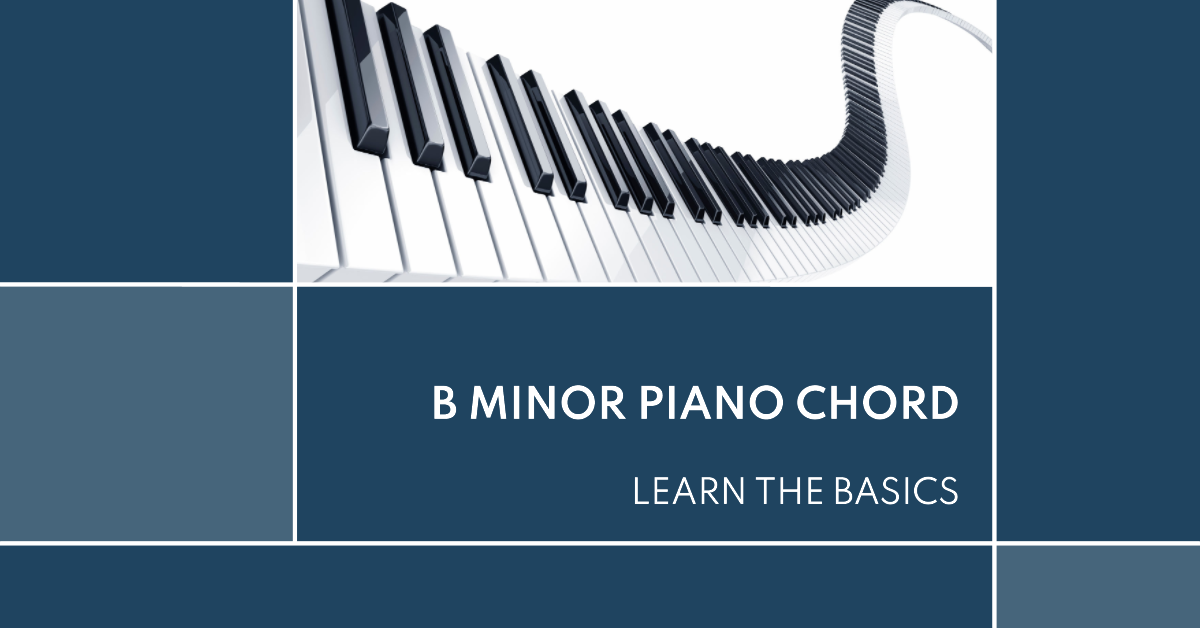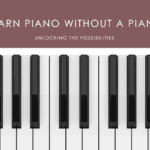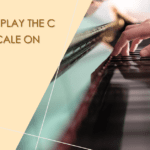Ah, the B minor chord. So melancholic and emotional, yet so beloved by pianists and music lovers alike. It’s a chord that has been used in countless songs, from classical to pop to rock, often evoking a sense of sadness or longing.
But what is it about this particular chord that gives it such emotional power? First, let’s talk about what the B minor chord actually is.
In simplest terms, it consists of three notes: the root note (B), the minor third (D), and the fifth (F#). When played together on a piano, this combination creates a hauntingly beautiful sound that can tug at your heartstrings.
But why does this combination of notes produce such an emotional response? One theory is that it has to do with how our brains process music.
Studies have shown that certain chords and musical intervals can trigger specific emotions in listeners. For example, major chords are often associated with happiness or joy, while minor chords tend to evoke sadness or melancholy.
When it comes to the B minor chord specifically, there may be additional factors at play. Some musicians believe that the relative complexity of this chord compared to simpler ones like C major or G major contributes to its emotional depth.
Others point out that its position within certain scales (such as A major) gives it a unique harmonic quality. Whatever the reason may be, there’s no denying that the B minor chord has a powerful effect on both listeners and performers alike.
Its melancholic beauty can transport us to another world entirely – one filled with bittersweet memories and quiet reflection. So if you’re looking to add some emotional depth to your piano playing, consider incorporating this wonderful chord into your repertoire!
The Basic Structure of B Minor Chord
When it comes to understanding the B minor chord, it’s important to first break down its basic structure. At its core, the B minor chord consists of three notes: the root note (B), the minor third (D), and the fifth (F#). These three notes together create a rich and haunting sound that is often used in music to convey a sense of melancholy or sadness.
To play this chord on the piano, begin by locating the B note on your keyboard. This note is located with two white keys to the left of a set of three black keys.
Place your thumb on this note, and then use your third finger to play the D note with two white keys above it. Use your fifth finger to play the F# note with two white keys above that.
One thing to keep in mind when playing this chord on piano is that you want all three notes to be played at once for full impact. You may need to adjust your hand positioning slightly or experiment with which fingers feel most comfortable playing each note simultaneously.
The Root Note: B
The root note in any chord is considered its foundation, providing a sense of stability and grounding. In the case of the B minor chord, this means that all other notes in this particular chord are built upon and centered around its root note: B.
Playing just this one note alone can already evoke feelings of mystery and suspense due largely in part due to its placement within music scales. The key of B minor falls within what’s known as “the relative minors” classification since it shares many characteristics with the D major scale.
The Minor Third: D
The next component in constructing our B minor piano chord after establishing its foundation through our root note is adding a minor third — so called because it sits three half-steps away from our root B. In this case, the minor third of our B minor chord is D.
The minor third note is what gives the chord its distinct sadness or melancholy sound as it contrasts significantly from the much brighter major third interval used in major chords. In B minor, this interval between the root note and the third note is two steps (or tones) smaller than it would be in a parallel major scale.
The Fifth: F#
We add F#-the fifth note to complete our B minor chord structure. The fifth adds depth and body to any chord and makes up a harmonic triad along with the other two notes of our chord.
The inclusion of F# means that we’ve moved up four half-steps from our D note which creates a subtle tension when played with other notes in this particular scale. It’s important not to overlook this seemingly small detail when playing because each element builds upon another creating a rich and complex musical experience for both player and listener alike.
Variations of B Minor Chord
Exploring the Different Inversions of B Minor Chord
The B minor chord is a staple in piano music, and it is common for composers to manipulate the notes of the chord to create different textures and moods. One way to achieve this is by using inversions.
Simply put, inversions are different ways of playing the same chord but with a different note than the bass. The first inversion of a B minor chord would have its third, D, as its bass note.
The second inversion would have its fifth, F#, as its bass note. When playing an inverted B minor chord on the piano, you will notice that each variation has a slightly different sound and feeling than the standard version.
For example, playing a first inversion B minor chord produces a more uplifting and brighter sound than when played in its root position. This is because having the third as the bass creates less tension in the overall sound.
On the other hand, when you play a second inversion B minor chord with F# as your bass note, you will notice that it has an even darker sound compared to its root position because it adds more tension to your melody. It’s perfect for creating suspenseful or dramatic moments in your music.
Chromatic Alterations: Sharping or Flattening Notes
Another way to create variations on basic chords like B Minor is by adding chromatic alterations such as sharping or flattening specific notes within those chords. Chromatic alterations refer to changing one or more notes in a scale by raising or lowering them by one half-step.
For instance, if we sharpened our fifth note (F#) by a half-step (upwards), we’d end up with Fx (F double-sharp). In effect we’d be playing an uncommon version of this triad; which would also work as an augmented chord.
Alternatively, if we flattened our third note (D) by half-step (downwards), we’d end up with Db (D flat). This creates a different tonality and mood altogether, turning our B minor into a B-diminished chord.
By understanding these variations of the B minor chord, you can add more depth to your playing and create more dynamic and interesting melodies. It’s important to experiment with these variations and discover how they can help bring out the emotions you want to convey in your music.
Common Uses in Music
B Minor Chord in Popular Songs
The B minor chord is a versatile chord that has found its way into countless popular songs over the years. One of the most iconic uses of the B minor chord in music is in Led Zeppelin’s “Stairway to Heaven”.
The song’s main guitar riff, which features the B minor chord, is instantly recognizable and has become one of the most famous guitar riffs of all time. Other popular songs that feature the B minor chord include “Eleanor Rigby” by The Beatles, “Viva la Vida” by Coldplay, and “Creep” by Radiohead.
Creating Tension and Conveying Sadness
The B minor chord is often used in music to create tension or convey sadness. In Western music theory, minor chords are generally associated with more melancholic and emotional qualities than major chords. The B minor chord specifically has a somewhat mournful quality to it that can be used to great effect in many different musical genres.
For example, in classical music, the B minor key is often used for pieces with tragic or dramatic themes. In addition to its use in classical music, the B minor chord can also be found in many different genres of popular music.
For example, it’s often used as a way to build tension before an explosive chorus or bridge section. In some cases, it may be paired with other chords (such as a G major) to create a sense of resolution after prolonged tension.
The Emotional Power of B Minor Chord Progressions
Beyond just individual uses of the B minor chord itself, many composers have explored the emotional power of entire progressions built around this chord. For example, a common progression used in pop ballads involves moving from a D major 7th chord to a B minor chord. This progression has a very emotional quality to it, and has been used in songs like “Someone Like You” by Adele and “Say You Love Me” by Jessie Ware.
Another example of a B minor chord progression that’s become popular in recent years is the “vi-IV-I-V” progression. This progression involves moving from a G major chord to an E minor chord, then to the B minor chord, and finally to an F#7 chord.
The melancholic quality of the B minor chord is particularly noticeable when it’s juxtaposed with the brighter major chords that come before it in this sequence. This progression can be heard in many modern pop songs, including “Royals” by Lorde and “Let Her Go” by Passenger.
Overall, the B minor chord is a powerful tool for musicians looking to convey sadness or build tension in their music. Whether used individually or as part of a larger progression, this versatile chord can add real emotional depth to any song it appears in.
Tips for Playing B Minor Chord
Hand Positioning
When it comes to playing the B minor chord, hand positioning is crucial. Start by placing your left-hand pinky finger on the B note, which is located with two white keys to the left of the middle C. Then, place your other fingers on the D and F# notes accordingly.

Make sure that your wrist is straight and that your fingers are arched over the keyboard. If you find that your hand feels strained or uncomfortable while playing this chord, you may need to adjust your posture.
Sit up straight in a chair with both feet flat on the ground. Keep your shoulders relaxed and avoid slouching forward.
Finger Placement
Finger placement is also important when playing the B minor chord. Use your index finger to play the D note, your middle finger for the F# note, and your pinky for the B note.
When pressing down on each key, use a firm touch but don’t press too hard – this can cause unnecessary tension in your hand muscles. Remember to keep all of your fingers close to the keys when not in use so that you can easily switch between chords as needed.
Practice Makes Perfect
As with any piano chord, practice makes perfect when it comes to playing B minor smoothly and accurately. Start by practising slowly and gradually increasing speed as you become more comfortable with this chord. You can also try breaking down this chord into smaller parts at first (e.g. playing just two notes at a time) before trying to play all three notes simultaneously.
This can help you build muscle memory and learn how each finger should move independently when playing this complex chord. Remember that every pianist has their own unique technique when it comes to playing chords like B minor – don’t be afraid to experiment until you find what works best for you.
Fun Facts about B Minor Chord
The Classical Connection
Although the B minor chord is often associated with modern popular music, it has deep roots in classical music as well. It was a favourite of composers such as Bach, Beethoven, and Brahms, who used it to convey intense emotions and create dramatic tension in their music.
In fact, the B minor chord is so prevalent in classical repertoire that it has been dubbed the “tragic” key by some musicians. One particularly famous example of the B minor chord’s use in classical music is Beethoven’s Symphony No.
9. The symphony’s final movement features a choral setting of Friedrich Schiller’s poem “Ode to Joy,” which begins with a somber B minor introduction before resolving into a triumphant D major chorus. This contrast between darkness and light perfectly showcases the emotional power of the B minor chord.
A Pop Hitmaker
While its roots may lie in classical music, the B minor chord has also become a staple of modern pop music. Many popular songs use this chord to create an emotional impact on listeners, whether they are aware of it or not. For example, “Someone Like You” by Adele features a prominent use of the B minor chord throughout its haunting melody.
Likewise, Ed Sheeran’s hit song “Photograph” employs this same melancholic flavour to great effect. Interestingly enough, one can trace this tradition back even further than modern pop hits: Bob Dylan famously used an alternate tuning with numerous chords including a prominent use of Bm for his classic song “Tangled Up In Blue.”
The Power of Pairing
One fascinating aspect of the appeal of the B minor chord lies not just with itself but with how it pairs with other chords within a given musical context. Take for instance how the B minor chord can be paired with a D major chord for maximum emotive impact. The Bm-D progression is a popular one for songwriters to use when looking to generate a sense of bittersweet melancholy in their music.
Another popular pairing is with the G major chord, which has been used in countless songs like “No Woman No Cry” by Bob Marley. The beauty of the B minor chord lies not just in its own inherent qualities, but in how it can work in tandem with other chords to create an even more powerful emotional experience for listeners.
Conclusion: Experimenting with the B Minor Chord
Playing the B minor chord on the piano is a wonderful way to convey melancholic and emotional feelings in your music. We’ve covered the basic structure of this chord and its variations, as well as how it is commonly used in music to create tension or sadness. We’ve also offered tips on how to play it smoothly and accurately.
While there are many songs that use this chord, don’t be afraid to experiment with it yourself. Try playing around with different combinations of notes, or incorporating it into your own compositions.
You might be surprised at how versatile this chord can be, even beyond its traditional uses. Remember that playing an instrument is all about expressing yourself creatively!
Whether you’re a beginner or an advanced player, don’t be afraid to take risks and try new things. The B minor chord is just one small part of a larger world of musical possibilities waiting for you – so go out there and explore!




